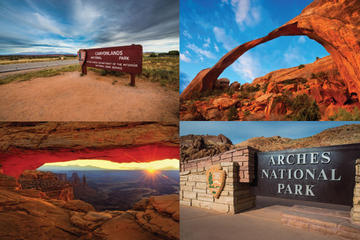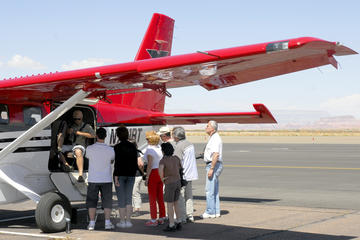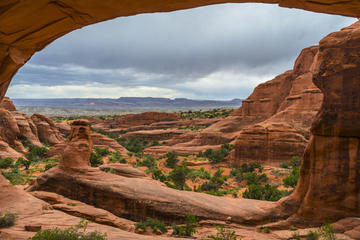Arches National Park
Stunning rock formations in the desert.
Arches National Park protects over 2,000 natural stone arches in Eastern Utah. Delicate Arch is the most famous arch in the world. Double Arch is the tallest in the park. And Landscape Arch has the longest span of any arch in North America.
Open / Close / Reopening Status of Arches National Park due to Coronavirus (COVID-19)
Please check the latest on the National Park website:
More information on Arches here
Last Updated: June 12, 2021
History
The human history of Arches extends back over 10,000 years. Prehistoric people used it for hunting and gathering, using the quartz they found there for tools like dart points, knives and scrapers. Ancestral Puebloans also began cultivating certain plants, such as maize, beans, and squash, and settled in the region. Traders and settlers came through in pursuit of pelts, ore, and grazing lands. Early newspapers in Moab featured editorials written by Loren “Bish” Taylor, who liked to explore the area north of the frontier town, sometimes with the town’s first doctor, John “Doc” Williams. Doc often visited a spot north of town now known as Doc Williams Point, where he let his horses rest and where he observed the rocks below. As word spread about the glorious views of the area, railroad executives and government-funded research teams visited. In 1929, Herbert Hoover signed the presidential proclamation that established Arches National Monument. The boundaries of the park were expanded several times by Presidents Roosevelt and Johnson, and in 1971, Congress and President Nixon changed the status to National Park.
Entrance fees
An entrance fee of $15 for motorcycles and $25 for private, noncommercial vehicles is charged at entry. The passes are good for seven days. The park offers an annual pass for $40 that is good for 12 months from the purchase date, and includes access to Canyonlands National Park as well. The national park pass ($80), senior pass ($10) and other national park passes are accepted at Arches National Park.
Location
Busiest Months (Percentage of Annual Visits)
The park is also a popular place for astronomy, photography, mountain biking, hiking and viewing wildlife. The park has an 18 mile scenic road with tremendous views and access to popular trailheads for arches.
Hiking Trails:
Hayduke Trail: A 812 mile long distance backpacking route across southern Utah and northern Arizona that starts in Arches and ends in Zion National Park after traveling through Canyonlands, Capitol Reef, Bryce Canyon and the Grand Canyon.
Rock Climbing:
Fishing Near Arches
For trout, try the alpine lakes in the La Sal Mountains. The Manti-La Sal National Forest has 8,100 surface acres of lakes and reservoirs that are popular spots for fishing. The Colorado River near Moab also holds catfish. They generally aren’t the huge fish available in other sections of the Colorado, but they can be fun.
Birding
The birds in the national park listed as common by the National Park Service include: American Goldfinch, American Kestrel, Ash-throated Flycatcher, Bewick’s Wren, Black Rosy-Finch, Black-capped Chickadee, Black-chinned Hummingbird, Black-throated Gray Warbler, Black-throated Sparrow, Blue Grosbeak, Blue-gray Gnatcatcher, Brewer’s Sparrow, Brown-headed Cowbird, Bushtit, Canyon Wren, Chipping Sparrow, Common Raven, Dark-eyed Junco (Gray-headed), Dark-eyed Junco (Oregon), Dark-eyed Junco (Pink-sided), Gray-crowned Rosy-Finch, Green-tailed Towhee, Horned Lark, House Finch, Juniper Titmouse, Lark Sparrow, Lazuli Bunting, Loggerhead Shrike, Mountain Bluebird, Mourning Dove, Northern Harrier, Pinyon Jay, Red-tailed Hawk, Rock Wren, Say’s Phoebe, Spotted Towhee, Turkey Vulture, Vesper Sparrow, Violet-green Swallow, Western Kingbird, Western Scrub-Jay, White-crowned Sparrow, White-throated Swift, Yellow-breasted Chat, and Yellow-rumped Warbler.
Birds
Weather Forecast:
[wunderground location=”Moab, UT” numdays=”4″ layout=”simple” showdata=”search,alert,daynames,highlow,pop,icon,text,conditions,date”]
Average Temperature (Monthly)
Radar:
Campgrounds and Lodging Options:
Devils Garden campground is 18 miles from the entrance of the park and a popular place to stay. The campground allows reservations and all 50 campsites are usually reserved from March until October. A road construction project will close the campground for much of 2017.
Hotels and motels are available in Moab, a small town located five miles south of the park. It is the closest lodging to the park – there are no restaurants or lodges in Arches.
Vacation Packages:
Roundtrip Flights to Salt Lake City
[tp_in_our_city_fly_shortcodes destination=SLC title=”” limit=15 paginate=false stops=0 one_way=false off_title=true subid=”” currency=”USD”]
What is Arches National Park famous for?
Arches National Park has the highest concentration of significant natural arches in the world. There are more than 2000 natural sandstone arches in the region including world famous Delicate Arch. The longest natural arch in the Western Hemisphere is located in the park – Landscape Arch. Arches also contains other unique geological features such as the Tower of Babel and The Organ.
Can you drive through Arches National Park?
Arches is accessible by a 36 mile (round trip) road through the park which provides access to The Windows, the Delicate Arch Viewpoints and Devils Garden. Many of the arches can only be seen by short hikes from the parking areas however.
What is the best time of year to visit Arches National Park?
The most popular months to visit Arches are May through September. The least visited months are November through February.
How far is Arches National Park?
Arches is located 5 miles from Moab, approximately 110 miles from Grand Junction, 230 miles from Salt Lake City, 350 miles from Denver, and 450 miles from Las Vegas.
How long is the hike to Delicate Arch?
The hike to the base of Delicate Arch is 1.5 miles (one way) from the trailhead parking and 2.5 miles (one way) from the overflow parking area. There is an elevation change of more than 400 feet.
How long does it take to see Arches National Park?
Visitors should plan a minimum of three hours to drive through the park with a half day to a full day providing a more substantial experience and allowing for you to undertake several hikes. If you would like to enjoy both Arches and Canyonlands in one trip, plan for two days. One day is possible in the summer when the days are longer but you are going to miss out on some of the experience as many of the famous arches are only available to see by hiking.
Which is better Arches or Canyonlands?
If you will only be in the Moab area long enough to enjoy one park, Arches contains the more famous geological features and receives more visitors annually. After all, Delicate Arch within Arches National Park is on the state’s license plate. If you are looking for more strenuous hikes, fewer people, or a four wheel drive adventure, Canyonlands would move up on your list.




